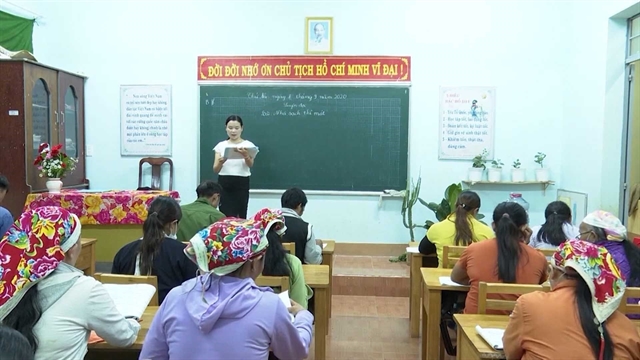 Society
Society


|
| Illiteracy eradication is considered an urgent task in the Central Highland province of Đắk Nông. — VNA/VNS Photo |
ĐẮK NÔNG — Aged 30, Sùng Văn Lành, a H’Mong man from a small village in the Central Highland province of Đắk Nông, cannot read and write.
Lành didn’t go to school. He stayed at home, doing whatever people hired him to do to earn a living.
He still has to ask other people for help whenever he goes to a local office to do administrative procedures.
"I'm embarrassed that I can’t read or write. I don’t want to go anywhere as I rely on others to do everything. I’ll do whatever they tell me. If I am deceived, I have to accept it," he said.
Lành is among more than 4,550 people who can’t read or write in Đắk G’long District. Most are ethnic minorities and reside in border and remote areas.
Illiteracy makes these people’s lives difficult. The work of illiteracy eradication has been identified as an urgent task.
Đắk G'long is the district with the highest illiteracy rate in the province. There are more than 45,300 people aged between 15 and 60.
The number of people who haven’t completed grade three is 4,550, accounting for 10 per cent of the total. For those who haven’t completed grade five, it is over 7,100 people, accounting for 15.9 per cent.

|
| Local people join a literacy class in the Central Highland province of Đắk Nông. As many as 17 classes have been held to help 505 local people read and write in 2021. — VNA/VNS Photo |
Lê Đại Thành, head of the district’s Education and Training Office, said that the office regularly opened literacy classes. Eight classes have been held since 2013 to help 271 people between 15 and 60 read and write.
Illiteracy also occurs in many other localities in the province.
By 2021, the province's population aged between 15 and 60 was more than 464,000, and 5.9 per cent were illiterate.
Phan Thanh Hải, deputy director of the provincial Department of Education, said the cause of illiteracy was due to unplanned migration of ethnic minorities. In remote and disadvantaged areas, the population is not concentrated, causing difficulties in organising literacy classes.
In addition, the opening of literacy classes mainly depends on the limited funding of the new rural construction programme, affecting the effectiveness of the classes.
Vi Văn Thuộc, Vice Chairman of Quảng Hoà Commune People's Committee, said the majority of local people were from H’Mông ethnic minorities, accounting for 79 per cent of the total.
Many can’t speak, read or write Vietnamese, so it is challenging to inform them about new policies or updated news.
The committee has held classes at night to help local people read and write. However, many didn’t join the classes, saying that they worked hard all day long and wanted to rest in their free time, he said.
Hải said the education sector has worked with the provincial People's Committee to issue a project on building a learning society with solutions such as coordinating all levels and sectors to educate local people about literacy classes and the importance of eradicating illiteracy, especially focusing on children, women and girls.
The sector would train teachers to be active in advocacy work in literacy. Hải said it would pay attention to investing in facilities and support disadvantaged students to join the classes. — VNS




